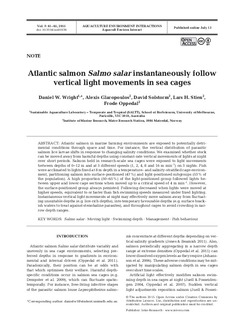| dc.contributor.author | Wright, Daniel William | |
| dc.contributor.author | Glaropoulos, Alexis | |
| dc.contributor.author | Solstorm, David | |
| dc.contributor.author | Stien, Lars Helge | |
| dc.contributor.author | Oppedal, Frode | |
| dc.date.accessioned | 2015-12-11T09:59:23Z | |
| dc.date.accessioned | 2016-01-20T13:39:12Z | |
| dc.date.available | 2015-12-11T09:59:23Z | |
| dc.date.available | 2016-01-20T13:39:12Z | |
| dc.date.issued | 2015 | |
| dc.identifier.citation | Wright DW, Glaropoulos A, Solstorm D, Stien LH, Oppedal F (2015) Atlantic salmon Salmo salar instantaneously follow vertical light movements in sea cages. Aquacult Environ Interact 7:61-65 | nb_NO |
| dc.identifier.issn | 1869-7534 | |
| dc.identifier.uri | http://hdl.handle.net/11250/2374379 | |
| dc.description | - | nb_NO |
| dc.description.abstract | Atlantic salmon in marine farming environments are exposed to potentially detrimental conditions through space and time. For instance, the vertical distribution of parasitic salmon lice larvae shifts in response to changing salinity conditions. We examined whether stock can be moved away from harmful depths using constant-rate vertical movements of lights at night over short periods. Salmon held in research-scale sea cages were exposed to light movements between depths of 0-12 m and at 5 different speeds (1, 2, 4, 8 and 16 m min-1) on 3 nights. Fish were acclimated to lights fixed at 8 m depth in a temperature- and salinity-stratified cage environment, partitioning salmon into surface-positioned (47%) and light-positioned subgroups (53% of the population). A high proportion (50-65%) of the light-positioned group followed lights between upper and lower cage sections when moved up to a critical speed of 4 m min-1. However, the surface-positioned group always persisted. Following decreased when lights were moved at higher speeds, equivalent to or faster than fish swimming speeds measured under fixed lighting. Instantaneous vertical light movements at night may effectively move salmon away from fluctuating unsuitable depths (e.g. lice-rich depths), into temporary favourable depths (e.g. surface brackish waters to treat against stenohaline parasites), and throughout cages to avoid crowding in narrow depth ranges. | nb_NO |
| dc.language.iso | eng | nb_NO |
| dc.publisher | Inter-Research | nb_NO |
| dc.rights | Navngivelse 3.0 Norge | * |
| dc.rights.uri | http://creativecommons.org/licenses/by/3.0/no/ | * |
| dc.title | Atlantic salmon Salmo salar instantaneously follow vertical light movements in sea cages | nb_NO |
| dc.type | Journal article | nb_NO |
| dc.type | Peer reviewed | nb_NO |
| dc.date.updated | 2015-12-11T09:59:23Z | |
| dc.subject.nsi | VDP::Landbruks- og fiskerifag: 900::Fiskerifag: 920::Akvakultur: 922 | nb_NO |
| dc.subject.nsi | VDP::Agriculture and fisheries science: 900::Fisheries science: 920::Aquaculture: 922 | nb_NO |
| dc.source.pagenumber | 61-65 | nb_NO |
| dc.source.volume | 7 | nb_NO |
| dc.source.journal | Aquaculture environment interactions | nb_NO |
| dc.identifier.doi | 10.3354/aei00136 | |
| dc.identifier.cristin | 1295145 | |

